
In Kathmandu it's a gloomy Saturday morning and the planned 8.55am Druk Airlines flight to Bhutan is delayed by four hours due to the lack of visibility surrounding the country's international airport in Paro situated at 2200metres. It is purportedly "the world's eighth most dangerous airport", according to Sonam, our young, smiling guide who greets us sporting his mustard striped gho and black hosiery, the national dress for men. We have descended through the dense cloud with sporadic jolts and bumps and veer sharply a few times to ensure the wings clear the sides of the surrounding gigantic hills as we line up with the runway. It runs parallel to the river which courses through the centre of the narrow scenic valley. Successful touchdown on the tarmac is a reassuring start to our planned six day stay in Druk Yul, Land of the Thunder Dragon, the last remaining Buddhist Kingdom in the Himalayas.
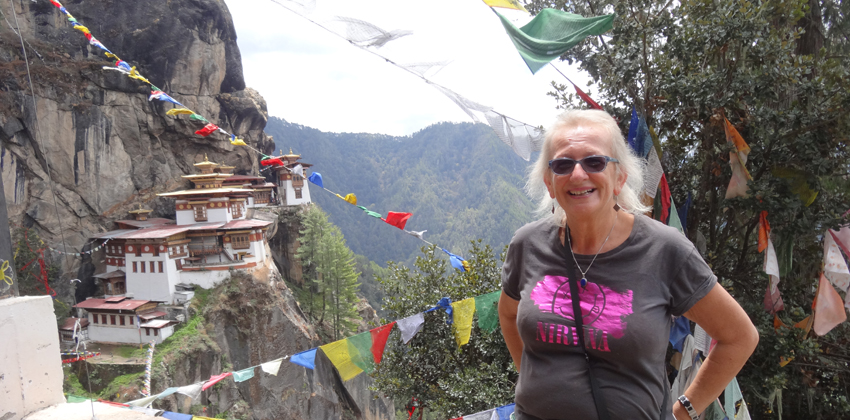
Arriving in mid afternoon, Sonam and the driver, Yonten, realise that we may be in need of some refreshment, so our first stop after passing through entry formalities on the ground is a little cake-shop, called surprisingly "La Brioche". In a small wooden room at the back of the shop, we drink hot tea accompanied by an éclair and a slice of pink, creamy "Huckleberry cake". Outside it is cold and dark for the hour of the afternoon, with low rain clouds obliterating the sun. Happily fortified against the wintry conditions and as snow flutters onto the surrounding mountainous peaks, we drive on towards Bhutan's capital, Thimpu, stopping at Chunzom, the confluence of the Paro and Thimpu Rivers where three chortens stand, each built in a slightly different style, one Nepalese, one Tibetan and one Bhutanese. The passionate expression of Buddhist beliefs and culture is evident everywhere in this mystical, mountainous country: in bright fluttering prayer flags adorning hills, bridges and mountain passes; in the stupas and chortens and monasteries; in the ubiquitous presence of red garbed monks, in the array of prayer wheels situated in many sacred and scenic places and in the presence of devotees spinning miniature prayer wheels held in their hands, mumbling prayers and performing the ritual of walking clockwise around their places of worship.
Beautiful Chore tn in Bhutan
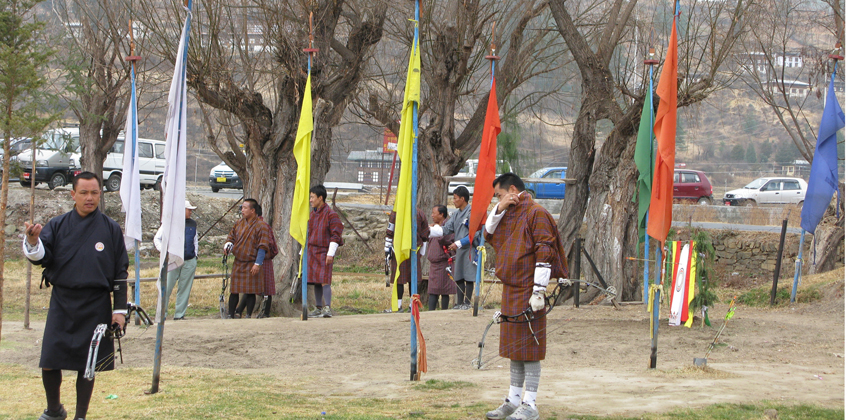
Arriving outside Hotel Jumolhari, in Thimpu, the unreality, the contrivance of some Utopian facade of society in this scenic undulating, cyprus green landscape which is populated by just under 650,000 inhabitants is, for me, confirmed. From the outset, it feels as if I have stepped foot into an imaginary land with an imaginary language. The currency is called the "ngultrum". The men, dressed by royal decree in their "gho" and the women in their "kira" ( a long skirt consisting of a long piece of woven fabric held tight around the waist with a contrasting woven band) and "toega", (a colourful bolero top) also look like costumed characters in a picturesque fantasy land. This mandated dress code for officials and people who represent Bhutan in any way to foreigners, is all part of the charmed life in the "world's newest democracy"( est 2008) where it is deemed by His Majesty King Wangchuck, that "Gross National Happiness" is more important than Gross National Product.
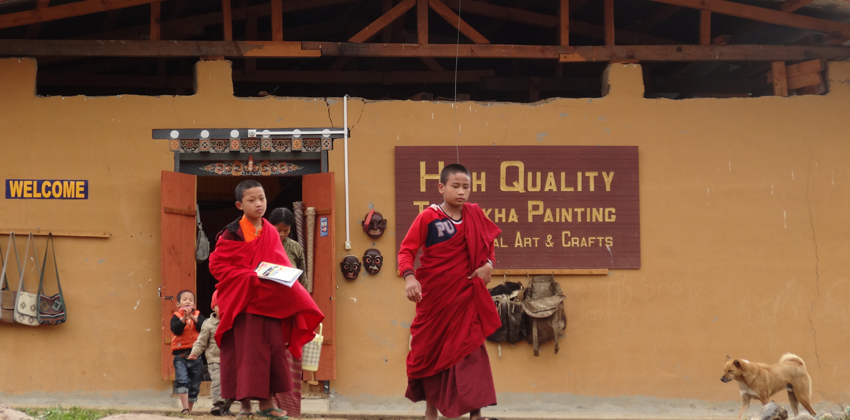
Patriotic " happiness" is embodied also in the national sport of archery. Cheerful looking men sporting multi coloured short skirts, congregate with their bows and arrows and, swilling some of the locally made whisky, aim at a distant target. When they are successful, their jubilation is translated into a little huggy group jig accompanied by joyously raucous caterwauling. It looks like a lot of fun, clearly a greatly bonding past time for the male participants and it is certainly thrilling to observe. The excitement of the tournament of swiftly flying arrows hitting targets is combined with the adrenaline producing potential for hideous accidents ever present throughout the contest. A chatty local informs me that each bright frond of the "skirt" worn by the archers represents a target achieved. This, I then realise, must account for the skimpiness of some participant's' quadriceps' covering, despite the bleakness of the chilly afternoon.
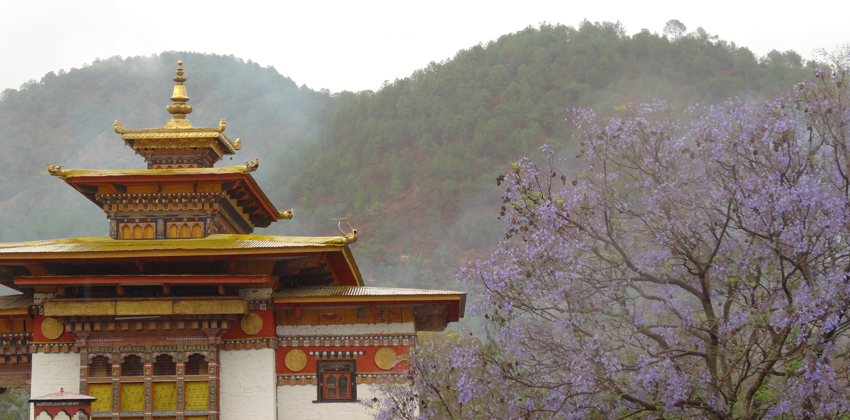
Thimpu itself is a small city, and, with its angled front to kerb parking system, seems in some surreal way, reminiscent of regional centres in rural Australia. The provision of parking spaces is where the simliarity ends. The ubiquitous phalluses which adorn the paintwork of many houses and their scultped forms which come in a variety of sizes and which act as door handles, internal decor and general bric a brac, seem at first, to me at least, somewhat exotic.
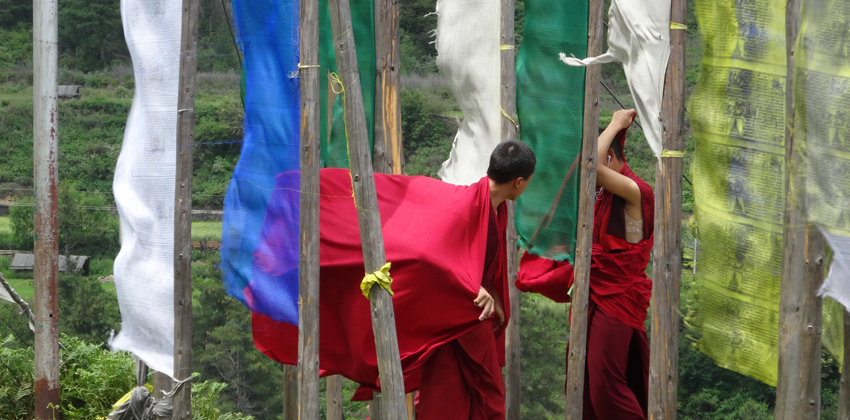
The taking of refreshments in a tea house not far from Punaka, a two hour drive across the mountains from Thimpu, blessed with a panoramic view across tilled rice paddies and barley and wheat fields with chortens and encompassed by the surrounding hills, took on an extra dimension with two giant carved phalluses standing proudly on welcome duty near the entrance. All we western travellers feigned polite nonchalance as we sipped our beverages, acting as if it was the most everyday thing to take tea in a remnant penile forest. Sipping genteely from my cup, I thought that the sign said "Wooden pens, 110 ngultrum". On second glance, after I had actually realised that the giant wooden toad stools near the door were indeed representative of objects of a more anatomical nature, I also realised with a lightening flash of insight, that the sign indeed read "Wooden Penis 110 ngultrum."
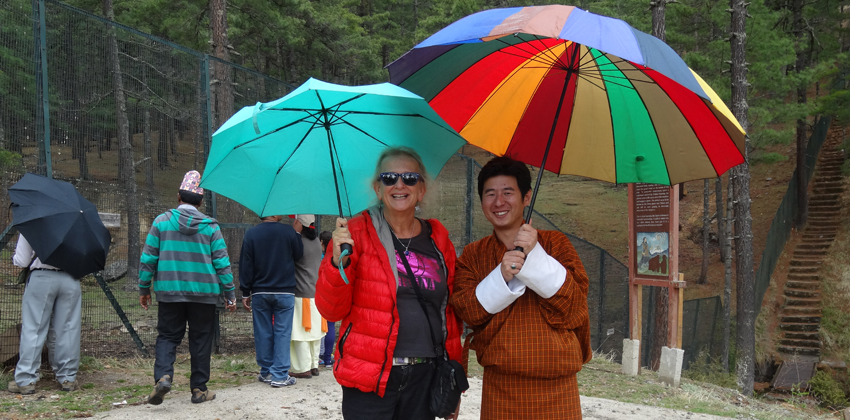
As Sonam, the sensitive and kindly guide pronounced a day or two later as we trawled through the picturesque Tachogang monastery between Thimpu and Paro, " Miss Julia, I am sorry to say, we have a somewhat male dominated society. He leaned towards me looking a little shame faced. "You see this yourself, everywhere penises! What house have you seen yet decorated with a vagina?" I had to admit, as I ducked my head under another diminutive entrance, this time the upper chamber of the gate house, that I had indeed not seen any. I sighed and nodded in earnest concurrence. Rest assured, however, that I am not taking this novel idea for domestic facade adornment back to the municipality of Rockdale, no matter how fervent my belief in the equality of the sexes.
It has to be said that earnest Sonam is not always solemn. As we hiked up the long, steep incline to the country's icon, the Tiger's Nest monastery, a short drive outside Paro, Sonam suddenly turned his cap around the wrong way, turned up the music on his iphone and started singing along to "Hotel California " as we heaved up the hill. We danced a little and belted out the chorus in unison. The scarlet rhodendron blooms interspersed everywhere throughout the surrounding dark green, sun dappled forest held no objection. Once we had reached the summit and the very holy temples of the monastery which sits at just over 3000metres, off came the cap, on went the large white sash over the top of his gho to reflect his low societal rank, it being a new democracy and all that, off came our shoes and on went Sonam's commentary about Buddha arriving in this place in the form of a tiger and this hermit saint who also dwelled here, and so on. By this stage, I needed fresh air and rest and so exited from the first cavernous incense clouded temple to breathe in the fresh mountain air and the breathtaking views of the snow clad peaks across the valley. Golden rooved, multi level "Tiger's Nest" Monastery sits majestically on a rocky outcrop and also resembles a divinely ordained, fairytale structure, some mad person's dream turned into superb stone architecture, overlooking the entire valley. It sits supreme on high and beckons all to climb up to its lofty sacred chambers.
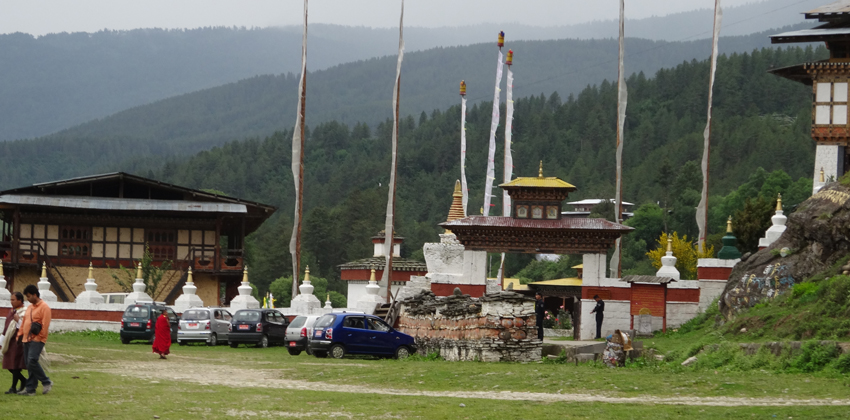
My companion on this journey, Mr Rishi Nepal, experienced mountain guide, Everest marathon runner 2012 and in his mid 30's and on his second trip to Bhutan, upon alighting from our Hyundai i35 at the beginning of the trail up to the monastery high above us, was talking horses.
"I think I take horse on path to monastery. You?"
" Oh, no. I will walk," I reply with barely hidden smugness.
Three minutes later, I am mounting "Nubo" with the assistance of his owner, an aged man with red beetel nut stained minimal teeth. Sonam grabs my pack. I implore him not to. I suggest I pay for a horse for him to ride too. "No, Miss Julia. I will walk. I take your pack. You must balance on horse." Rishi's horse starts lumbering over the stones and mine starts to follow, then stands still. Sonam, with my backpack, umbrella, camera and water starts bolting up the hill. "Yeeyah!" cries the horse handler and Nubo obligingly steps daintily forward. Sonam appears from time to time out from behind bushes and rocks, taking photos and video clips of Rishi and myself lumbering in our saddles up the hillside. Nubo steps perilously close to the edge of the steep path from which the hill side drops precipitously. I squawk. The horse handler grabs my bottom with supreme professionalism. I know I am in good hands. As the horse bells tinkle with their gentle motion and the ascent brings us ever more dramatic views of the mountains and valley below, I feel quite at ease on Nubo, less at ease with the occasional hand securing my seat, and pity Sonam darting burdened with all my possessions up the steep incline. He took some worthwhile photos for us though. "You must not have to feel sorry for him. That's his job!" says Rishi, rocking comfortably on his mount. We reach a broadening of the path in a clearing marked by a giant prayer wheel and suddenly I am to dismount. Here there is a cafe where the superb view of the monastery perched still high above us is framed by dark pink pompoms of rhododendron flowers. We drink hot fragrant tea and munch on crisp savoury crackers whilst seated on a bench with the magnificent view before us. A friendly cat head nuzzles us, earning cracker crumbs in return. This was the end of the horse help. From here we climbed on foot. The off duty Nepali guide may have had an inspirational idea after all. I have sat in the car listening to the Nepali conversation animatedly flowing between Sonam and Rishi, sometimes able to understand the subject at least, often glad just to be able to rest and let them chat and occasionally requesting translation. It generally feels soothing. I am amazed at Sonam's linguistic competence. His English is very good as his Nepali according to Rishi. His native tongue is Dzongka.

Lunch was taken on this excursion at another mountain hut much higher than our morning tea stop. We sat outside on timber stools with astounding views over the mountainous countryside. If not for the fare on offer, and for the experience 40 minutes before of entering the Buddhist temples on high, for a minute, I could have thought I was lunching in the Austrian Alps. We kicked off our lunch with an aperitif of lychee juice. I skipped the entree of "riverweed" soup which I had already stoically tried on Sunday in between our short drive to meet Bhutan's national animal, a large docile grey rock like animal called a tarkin in Thimpu's "mini zoo" in which only tarkins are kept, and our inspection of the large and impressive "dzong" in Thimpu. Herewith an admonition: Do not save up to come to Bhutan just to try the riverweed soup. You can easily get the idea at home. Simply take a litre of water including any aquatic vegetation visible, from your local swamp, heat and serve. Maybe don't use this as your audition recipe for the next series of "Masterchef" either. For mains, on the mountain hut buffet, there were the usual steamed "red rice", braised cabbage, steamed seasoned mixed vegetables and "chilli cheese." Chilli cheese, green chillies sauteed in a creamy cheese sauce, appears as an option at all buffets and adds a nice little hint of succulent spiciness to everything else on offer. Rishi also liked its flavour and texture but felt it did unbecoming things to the chemistry of his intestines. Steamed fern fronds were not on offer there but, along with green asparagus, is in abundance generally at this time of the year in Bhutan. Surprisingly I find them quite palatable but please do not rush to fry some up for me once I get home again. At the foot of the mountain whilst awaiting us, Yon- ten our 27 year old reliable and helpful driver had spent a productive 5/ 6 hours chatting to a pretty local girl and was on a bit of a high. Did I think they might make a good match? I was already familiar with the astrological imperatives of match making in this region. He took her mobile number. I told them I will return to Bhutan for the wedding. She laughed shyly.
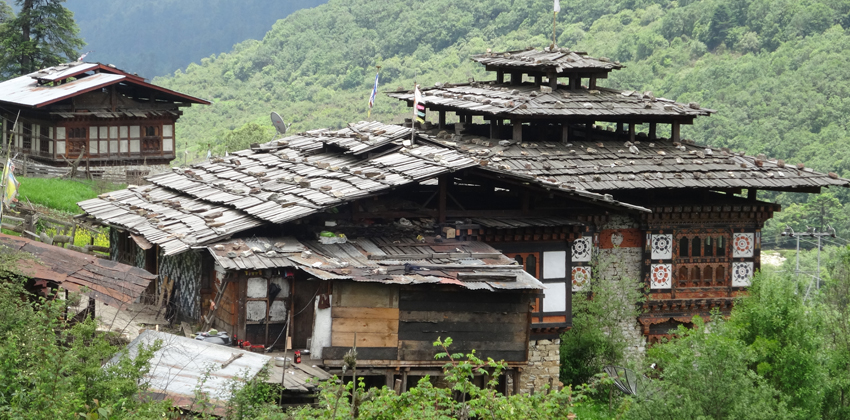
Yesterday very early in the morning I arose at 4.30 to leave Paro and Bhutan. My sleep deprived head was full of images of men in belted checked robes and long black socks, of the divine mad man who is revered everywhere and whose name was mentioned at each impressive dzong, a combined administrative and religious building whose architecture sits stunningly in the steep landscapes; of the mist teeming across the Donchu La mountain pass smothering its 108 chortens but somehow adding to the beautiful mystique of the place; of the verdant forests illuminated by the masses of spring flowering rhodendrons and magnolias flowering in all shades of red and white and pink. I saw the archers with their steel bows firing across the grass, the shaven headed monks and nuns in red and the stunning painted woodwork which adorns every building in this unusual country. I had the Giant Buddha who sits above Thimpu high on a hill smiling benignly, also clearly in my mind.
At takeoff we again successfully skirted the hills and within minutes, I was confronted by a magical realm of infinite white peaks stretching to the horizon from my window seat on the right side of the plane. Kanchenjunja, Makalu, Everest and dozens of others all glistening white in the morning sun above the clouds. The thick snow adorning even these giant peaks is most unusual for this time of the year. Landing back in the mid morning chaos of Kathmandu, I felt as if I were coming home.
Julia Ruhl